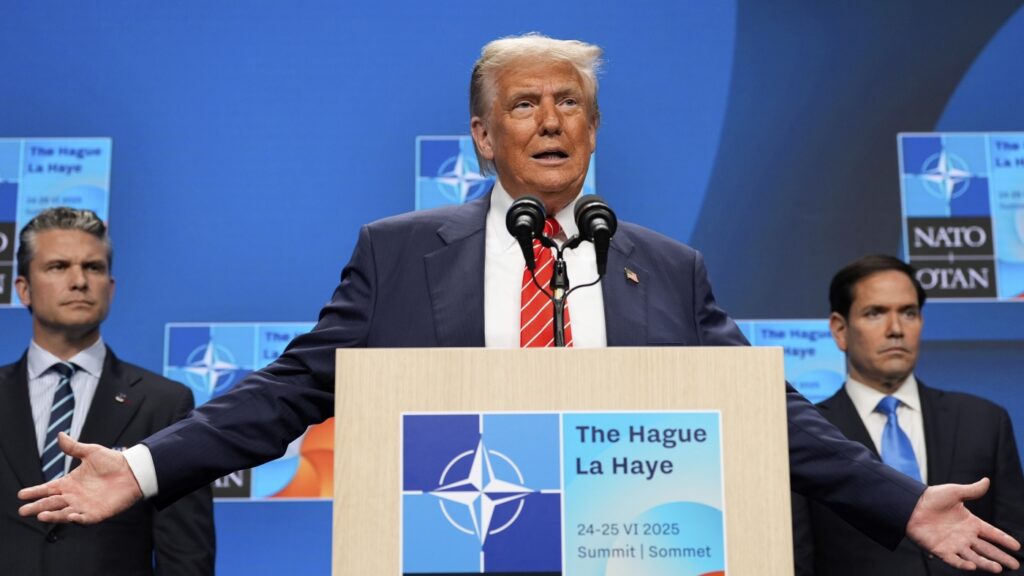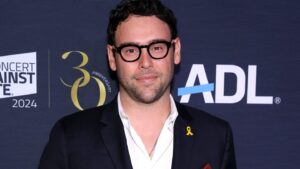
President Donald Trump speaks during a media conference at the end of the NATO summit as Foreign Secretary Marco Rubio, right, and Defence Secretary Pete Hegseth listen, in The Hague, Netherlands, Wednesday, June 25, 2025. (AP Photo/Alex Brandon)
THE HAGUE, Netherlands — In a move described as “transformational” and “historic,” NATO’s summit in the Netherlands on Wednesday marked a pivotal moment for the alliance. “We’re witnessing the birth of a new NATO,” declared Finland’s President Alexander Stubb, as the 32-member organization endorsed a plan to significantly increase defense spending, echoing Cold War levels, largely driven by U.S. President Donald Trump’s influence and rising security concerns regarding Russia.
Immediate Impact of the NATO Summit
The summit’s decision to increase military budgets represents a major shift in defense policy for NATO’s European members and Canada, potentially costing tens of billions of dollars. This nonbinding agreement aims to raise defense spending targets from 2% to 3.5% of GDP by 2035, allowing members to count military support to Ukraine towards these targets.
Tens of billions of dollars are expected in new military spending as NATO members adjust their budgets to meet the new targets.
However, not all members are aligned. Spain has officially refused to comply, while Slovakia expressed reservations. Countries like Belgium, France, and Italy face challenges in meeting these new financial commitments.
Key Details Emerge: U.S. Commitment to Collective Defense
The summit also reaffirmed NATO’s “ironclad commitment” to its collective defense clause, Article 5, which had been questioned due to President Trump’s previous comments. With the new spending commitments, Trump expressed satisfaction, stating, “I left there saying that these people really love their countries. It’s not a ripoff. And we’re here to help them protect their country.”
“They want to protect their country, and they need the United States, and without the United States, it’s not going to be the same,” Trump emphasized.
A Sidelined Ukraine in Focus
In contrast to previous summits that emphasized Ukraine’s potential NATO membership, this meeting shifted focus. While Ukrainian President Volodymyr Zelenskyy was present and engaged with leaders, the final summit statement did not highlight Ukraine’s membership prospects. Instead, it reiterated NATO’s commitment to supporting Ukraine.
Despite this, the summit did acknowledge Russia as a significant security threat, a critical point for member states justifying increased defense expenditures.
Industry Response and Future Implications
The summit’s outcomes underscore the United States’ influence within NATO, with a concise agenda crafted to align with President Trump’s priorities. NATO Secretary-General Mark Rutte’s supportive message to Trump, shared on social media, highlighted the U.S.’s pivotal role. Following the summit, Trump remarked on the camaraderie among leaders, noting, “almost every one of them said ‘Thank God for the United States.'”
NATO leaders were described by Trump as a “nice group of people,” reinforcing the alliance’s unity and shared goals.
The announcement comes as NATO seeks to adapt to evolving security landscapes, with a focus on infrastructure upgrades and network protection. Progress on these initiatives will be reviewed in 2029, post the next U.S. presidential election, setting the stage for continued collaboration and strategic planning.
What Comes Next for NATO?
As NATO members work to meet new spending targets, the alliance will face ongoing challenges in balancing economic pressures with security commitments. The summit’s decisions mark a significant shift in defense strategy, with implications for international relations and future security policies.
According to sources familiar with NATO’s strategic goals, the organization will continue to adapt to global threats, with a focus on maintaining unity and resilience among its members. The timing is particularly significant as geopolitical tensions remain high, necessitating a robust and coordinated defense posture.
In conclusion, the NATO summit in The Hague has set a new course for the alliance, emphasizing increased defense spending and reaffirming the importance of collective security. As member states navigate these changes, the focus will remain on ensuring stability and preparedness for future challenges.







